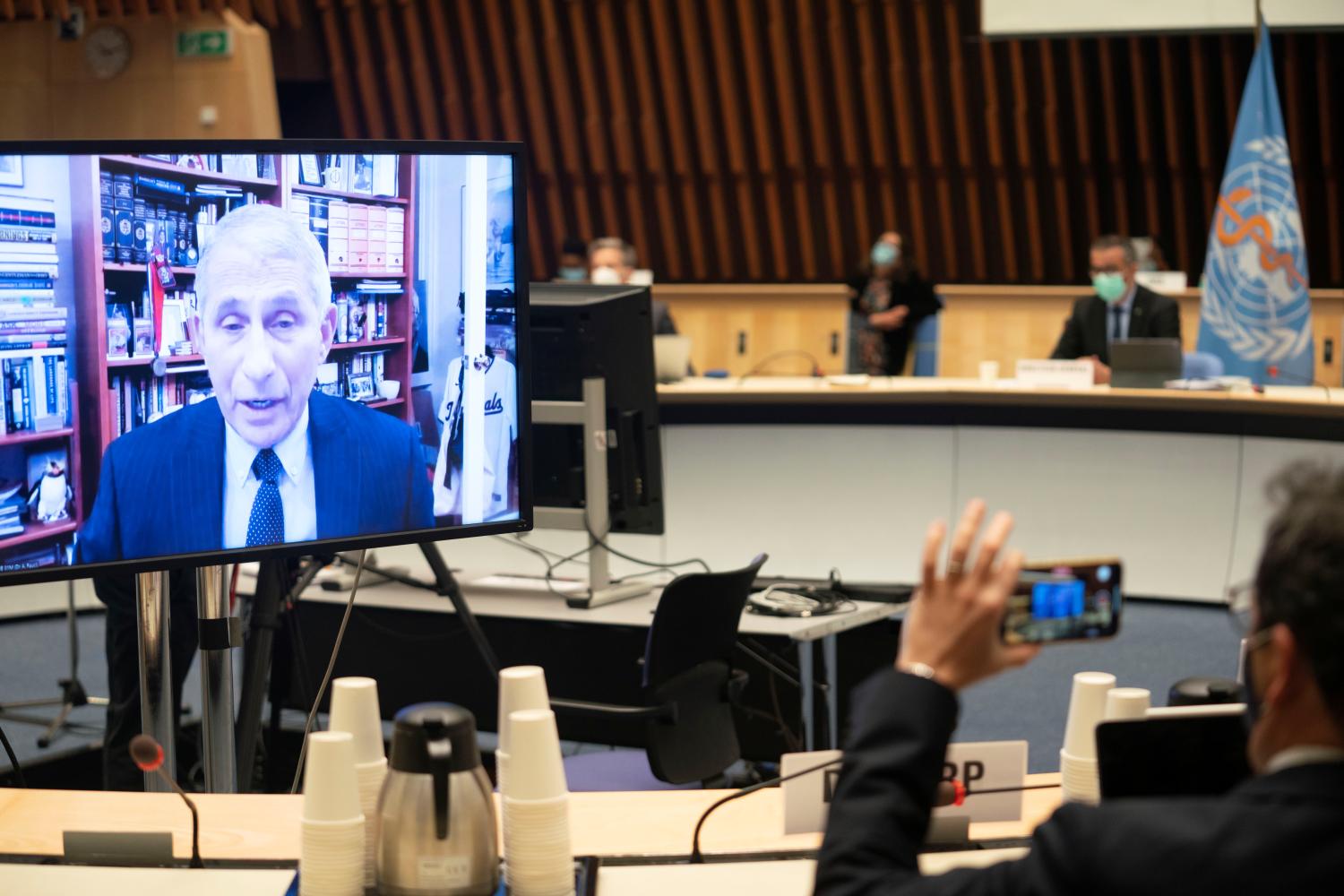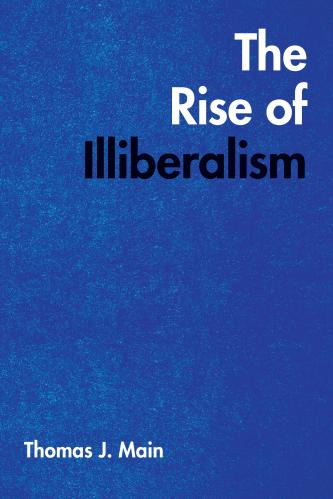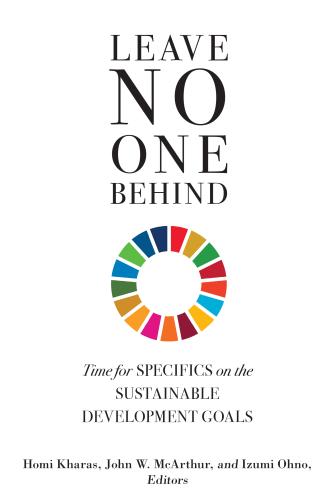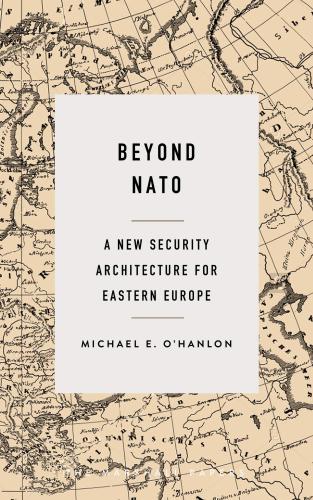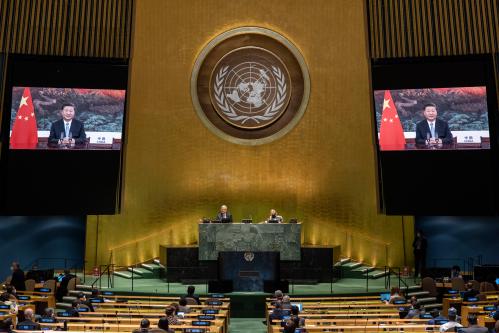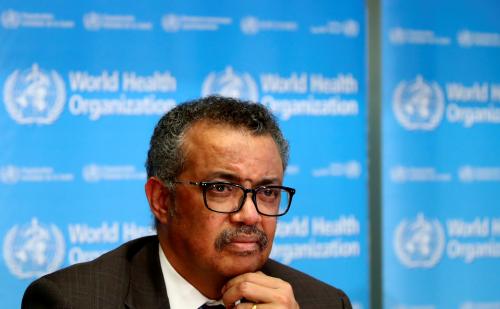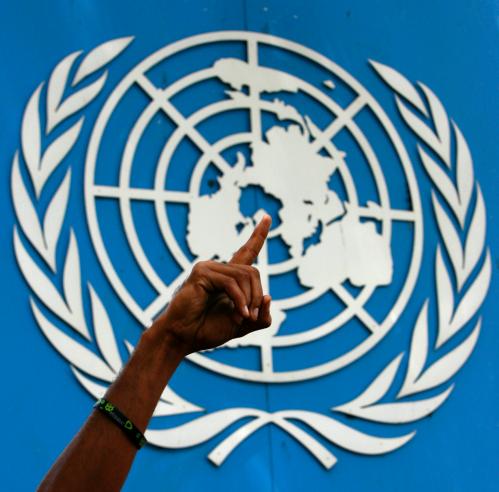This brief is part of the Brookings Blueprints for American Renewal & Prosperity project.
Contents
- Summary
- Challenge
- Cooperation among democracies: A short history
- Beyond the West
- Policy recommendations
- Conclusion
Summary
Democracies still have great influence in the international system, but the challenges to their grip on the order are mounting. New forms of cooperation among powerful democracies, beyond the West, are needed if core systems are to be preserved against efforts by China and other non-democratic states to undermine them or change their character.
Not every aspect of China’s growing influence is negative, but enough of it is to cause concern and motivate new approaches to international affairs. One dimension of a response to China’s influence should be to amplify coordination and cooperation among democracies in defense of the key elements of our multilateral order. But if we seek greater cooperation among democracies to defend key values and interests, how can this best be arranged?
The United States should adopt a strategy we call “democratic multilateralism” — seeking to advance coordination and cooperation among the democracies, but within the contours of the multilateral order. The U.S. — or another leading democracy — should establish a mechanism for tight coordination among the democratic states on both policy and funding for issues of technology, global health, and climate change. Going further, the U.S. could establish a “Partners Council on International Security,” which would operate in parallel to the U.N. Security Council and invite to this Partners Council its most important democratic allies and partners. These mechanisms would bolster multilateralism, not erode it, and they would keep open the necessary mechanisms for coordination with illiberal states on global issues. Where the democracies can narrow their differences and coordinate their policy, they will gain more than they lose. Constraining Russian and Chinese efforts to weaken or change the character of the contemporary order will help to preserve the democracies’ influence at a critical juncture in world affairs.
Challenge
It is now widely accepted that China poses the central challenge to American foreign policy in the first half of the 21st century. But what is the nature of that challenge?
The situation today bears little resemblance to the Cold War. Although China’s growing naval reach, technological prowess and advanced missile capability threatens America’s forward naval posture in Asia, it would be an exaggeration to say that China yet poses a direct military threat to the United States or even to its allies and security partners, beyond Taiwan.1 On the other hand, China has laid the foundation for great influence in global affairs in the realm of global economics, trade, investment, and development; in advanced information technology, including artificial intelligence; in energy markets and climate change; in global public health; and in nuclear proliferation. It has advanced economic and diplomatic power to influence deliberation on those issues in every region of the world through targeted investments in Europe, Latin America, and Africa, with allies and partners in western Asia, and in collaboration with Russia in the Arctic. The fact that Beijing has at times been perniciously aided by Russia or taken low-risk advantage of Moscow’s high-risk adventurism, adds to Western concerns about China’s intent.
What’s more, China has carefully but continuously advanced its capacity to wield influence in that set of multilateral institutions that undergird and shape the rules of globalization. Its initial move was to gain sway in the secretariats of specialized bodies like the International Telecommunication Union (or ITU, which sets the global rules for cellular communications) and the World Health Organization (WHO), all while Washington was paying very limited attention. As its influence and confidence has grown, Beijing has also begun flexing its muscles in international security bodies like the U.N. Security Council and Comprehensive Test Ban Treaty Organization (which monitors nuclear weapons testing around the world).
The China challenge, in short, is a challenge of international order; and specifically, of the multilateral order in which so much of the world is embedded. Not every aspect of China’s growing influence is negative, but enough of it is to cause concern and motivate new approaches to international affairs.
The China challenge, in short, is a challenge of international order; and specifically, of the multilateral order in which so much of the world is embedded. Not every aspect of China’s growing influence is negative, but enough of it is to cause concern and motivate new approaches to international affairs.
The exposure of the U.S. and the West to these global dynamics is, by now, enormous — deeply enmeshed in globalization, and widely exposed to the production and management of global public goods. This concept is oddly absent from American policy debates, even though American exposure to global public “bads” — disruptive climate change, pandemic disease, financial crises — has grown exponentially over recent decades. Dealing with China’s growing military weight in Asia will require one type of Western response, primarily in the naval and technological spheres. But the broader challenge of a global China will require a multi-pronged strategy. One dimension of the response should be to amplify coordination and cooperation among democracies in defense of the key elements of our multilateral order.
Cooperation among democracies: A short history
The question of the relationship between democracy, international order and American foreign policy has long been debated. Much of the history is checkered, at least. It has been written about amply elsewhere and need not be elaborated here; in a parallel piece (forthcoming) we recount some key evolutions and debates that can help situate current policy options.
Previous efforts to forge instruments for deep coordination of the democracies, especially the Concert of Democracies, foundered over two things: divisions among the democracies over American actions in Iraq; and a desire not to foster an outright break with China, one that would forestall economic ties with that vast market. However, China’s behavior of late has begun to shift the calculation of many elites in New Delhi, as well as in Berlin and other European capitals. This may have begun to ease key concerns among other leading democracies that a mechanism for democratic coordination would be seen as threatening to China, since for now, China’s strategy is increasingly viewed as inimical to core values and interests.
Still, if the United States wants now to advance the argument that democracies should have great influence on the character of international affairs, it must grapple with two key realities:
- That the democracies in question lie not only in the comfort zone of the trans-Atlantic West, but well beyond it. Additionally, some of these key players have been on the wrong end of past American reversals or hypocrisies around democracy promotion, adding to skepticism about aligning on ideological grounds; and
- That the issues of global public goods and bads — issues like climate change and financial stability — can no longer meaningfully be managed without extensive Chinese action. The question of whether democratic alignment aids or limits that action is an important test of any democratic coordination efforts.
What’s more, any American initiative in 2021 or beyond has to be set against the backdrop of the core duality of the four years of President Donald Trump’s foreign policy: a welcome degree of toughness on China (albeit shambolically implemented), and a wholly unwelcome degree of unilateralism in its execution. (As it does against widespread international and domestic perception that the American democratic model suffered a blow — perhaps not a body blow, but a blow nonetheless— from a combination of politicization of the Department of Justice and from Trump’s conspiratorial claims of fraud during the 2020 presidential election; issues and dynamics addressed elsewhere in this series.)
Beyond the West
As China has shed its hesitation about flexing its economic and diplomatic muscles on the world stage, and acted both intrusively and aggressively in capitals from Stockholm to Ottawa to Seoul, wariness about China’s new power has grown, and countries have begun to reconsider their choices. This includes India, among other non-Western democracies. That matters, because the balance of power in the international system still lies with the democracies — but only if you look beyond the traditional trans-Atlantic core.
At the end of the Cold War, the democratic Western allies held an extraordinary preponderance of power in the international system. With the collapse of the Soviet Union, the only major non-Western military power withered. The Western democracies collectively held more than 80% of world GDP. In military affairs, international finance and trade, and the U.N. system, the West held easy sway, able to block any initiative it did not seek and advance most initiatives it sought. Among developing nations, the Western model was the only model available, and it was to the West that developing nations had to turn for financial and developmental support.
Within two decades, though, Western dominance of the international system was becoming a victim of its own success in two very distinct respects. As globalization spread outwards, particularly to Asia, the Western economies profited handsomely but exceedingly unequally. When the global financial crisis hit, it hit hard, amplifying anti-globalization sentiment and bolstering populist politics in the Western democracies.
At the same time, the rise and then rapid post-crisis recovery of non-Western economies titled the balance of global influence away from Western dominance. The impact of the so-called BRICs countries — Brazil, Russia, India, and China— was substantial and gaining. And while the BRICs were never united in strategic terms, they did share an agenda of resisting Western dominance of the international economic order. They united in opposition to the Washington Consensus; countries like India and Brazil had suffered under the excesses of this theory of neo-liberal economics and were using their newfound weight in international affairs to push back. Freedom from excess pressure from the West was a central unifying goal for these countries — more important than occasional strategic tensions between them.
By the time the eurozone crisis extended the effects of the global financial crisis, the division of international weight between the West and the BRICs was approaching equivalence. For a time, it looked like the BRICs would constitute a coherent counterweight to the West through which China could wield substantial diplomatic and economic influence.
But China has squandered at least some of the space it gained from this dynamic. Rather than consolidating its position as the largest and most influential of the BRICs and building on early efforts like a BRICS Development Bank, China’s relations with some of its fellow members has soured. In Brazil, civil society and private sector interests have chafed under Chinese efforts to acquire extensive land and resources, while the government pushed back on what it deemed excessive Chinese efforts to place controls on internet freedom. On India’s contested northern border, China has engaged in aggressive military posturing and limited incursions into the territory, aggravating Indian political and popular opinion and stoking fears about Chinese dominance in Asia. And beyond the BRICs, China has engaged in very aggressive diplomacy in several European capitals; taken two Canadians hostage in reaction to an American request that Canada arrest a Chinese financial official suspected of violations of American law; and used both influence operations and tariffs to try to bully Australia on policy. All this, in addition to its increasingly assertive posture in the South and East China Seas and heightened repression internally and in Hong Kong, has eroded much of Beijing’s potential appeal.
That leaves open the possibility that a new approach might gain favor with a wider swathe of democracies beyond the traditional trans-Atlantic core.
Bringing in non-Western democracies is critical for several reasons. In international economic terms, if the non-Western democracies are added to the mix, then the democracies hold 75% of global GDP, far surpassing the authoritarian states. In military terms, there’s both the preponderance of total military spending, and the important facts of geography — Japan and India are well-placed to aid in efforts to constrain China in the western Pacific and Indian Oceans. In technological pursuits, including India in the ranks of democratic collaborators adds not only a vibrant technology sector but a population size that can help balance the scale in terms of volume of available data — a key advantage in the looming artificial intelligence race.
Finally, there’s the simple matter that two capitals once skeptical of the Concert of Democracies — Tokyo and New Delhi — respectively represent the second wealthiest and the most populous democracies in the world. To advance a major instrument of international architecture for the democracies without their participation would profoundly weaken its credibility. The participation of Brazil, the 12th largest economy in the world and the fifth most populous democracy, would also eventually be highly desirable.
It is critically important that any strategy aiming to advance cooperation among democracies proceeds apace with internal efforts at reform.
Of course, Brazil and India are at present enmeshed in difficult politics and are still flawed democracies; in the case of Brazil, perhaps deeply flawed. But so, too, is the United States. It is critically important that any strategy aiming to advance cooperation among democracies proceeds apace with internal efforts at reform.
Again, though, awareness of the flaws and limitations of existing democracies should not blind us to the profound advantages of the democratic model, or to the profound flaws of China’s, to say nothing of Russia’s contemporary klepto-dictatorship. Although several of the non-Western democracies were subject to American excesses or abuses during the Cold War and, later, of the Washington Consensus, few of them are so naïve as to believe a Chinese-driven order would be preferable to even a flawed American-led one. American diplomacy that takes a “shining beacon” approach falls on deaf ears in these capitals. But a clear argument about geopolitical alignment that matches core interests in areas like internet freedom, market commerce, open maritime order, and constraint of China’s growing influence, may resonate.
Policy recommendations
All of this leads to an essential question: if we seek greater cooperation among democracies to defend key values and interests, how can this best be arranged? What pathways have the greatest odds of success?
Alternative models
In the face of China’s advancing influence, some have argued for casting back to the idea of a Concert of Democracies. But in its most fulsome form, if it is understood as a way to leave behind the U.N. Charter and the Treaty of San Francisco, it would be an order-shattering rather than order-creating mechanism. Notwithstanding mounting concern over Chinese intentions, most countries are seeking to blunt its advance, not enter into full confrontation with Beijing. For this reason, above others, the full-blown version of a concert of democracies will still likely be viewed with great concern in New Delhi, Tokyo, and Berlin, and even in reliably supportive democratic allied capitals like Canberra and Ottawa.
During his campaign for the presidency, Joe Biden promoted the idea of a Summit of Democracy. As currently conceived, this is an informal mechanism that would simply bring the leaders of the democracies together and ask them to make commitments both to improving the quality of their own democracies and to advancing or defending democracy internationally. The model draws upon the preceding Nuclear Security Summit and the Open Government Partnership. It has the important advantage of twinning internal reforms with international defense of democracy — an approach which may be uncomfortable for some but is vital for the credibility of the enterprise. It remains to be seen, though, what sustainable outcomes this initiative could have.
A third approach would have more systemic effects, but still fall short of breaking the established order. This approach — which we call democratic multilateralism — could emerge as an elaboration of the summit. The simple point would be to build new mechanisms for advanced democratic collaboration within the existing multilateral order.
Surprisingly, those mechanisms do not yet exist in several major policy domains, though there are some fledgling efforts that could be built upon in the technology domain and through the Quad (Japan, Australia, United Kingdom, and the United States). Within the International Monetary Fund, the G-7 nations, representing the world’s main economies and including key Western democracies, do coordinate on policy, though as yet this excludes India — whose economy is larger that of France, Italy, or Canada. Beyond that, cooperation and coordination are far more limited. Within the World Trade Organization (WTO), reforms to the governance mechanisms have moved from small-club approaches to inclusive “consensus” based approaches, which have proved unwieldy, and have done nothing to advance the business of coordination among democratic states. Within the World Health Assembly (the governing body of the WHO), similar consensus rules apply, and there is no standing mechanism through which the main democracies cohere their approach — even though just the top democracies collectively pay the lion’s share of the costs of the WHO. And, critically, in the U.N. Security Council, America traditionally consulted on policy with France and Britain, creating a “P-3” group that carried great sway; that tradition has faltered of late, and of course does not bring India, Japan, or Germany into the Security Council’s deliberations.
The key advantages of this democratic multilateralism are threefold. First, any mechanisms established to advance this collaboration would not be order-shattering devices. A series of mechanisms, distributed across major policy domains and international institutions, would advance democratic coordination without going so far as to establish a bloc. This would lessen the risk of triggering a direct clash with Beijing, and is therefore more likely to be acceptable in Berlin, Tokyo, and New Delhi. In New Delhi, there continues to be hesitancy about overt alignment with the United States or overt use of government systems criteria as a dividing line within the international order, but there is increased willingness to contemplate what is referred to as values-based multilateralism — an approach entirely consistent with the notion of democratic multilateralism advanced here.2 Second, it would be a salve against deep European concerns about American unilateralism, recently amplified by Trumpism. And third, it would not rule out tactical collaboration with non-democracies, either on transnational threats like terrorism or on global public goods like climate change.
Diplomacy and parallel structures
Within this broad approach, how could greater collaboration be achieved? The answer depends in part on the pre-existing degree of structure within the international system.
In areas where international governance is thin, as in advanced information technology, the best approach is likely to be that of nested groups. Some have advocated for expansion of the G-7 to incorporate India, South Korea, and Australia into a “D-10” focused on technology, thus bringing together the 10 largest democracies by economic size. Others have called for a similar mechanism that also includes Taiwan and Israel, both industry leaders in key technology domains, or a wider swath of the larger democratic economies. While that is fine to advance areas of common investment, it will not suffice when it comes to warding off Chinese, Russian, and other states’ efforts to weaken the liberal character of existing technology rules. There, the democracies — and their major private sector actors — could work together within the ITU to advance common positions and compete more effectively in running candidates for leadership positions of the institution.
Similarly, in global health. Collectively, the U.S., U.K., Germany, and Canada contribute over 40% of the WHO’s funding, and the democracies as a whole constitute almost 80% of the funding, versus China’s 2% — and yet frequently find themselves on the back foot in negotiations within the WHO’s governing board. This arises from three phenomena, all of which need correcting: Washington pays only episodic attention to the workings of the U.N.’s specialized agencies; there are important differences in philosophy about multilateralism between Washington and the rest of the West; and China has moved into an advantageous position in its bilateral relationships in the developing world, whose countries make up a majority of seats on the governing board of the WHO.
The first two points can be addressed at the level of policy coordination. The third point requires more focused effort and a willingness of major democratic powers to join forces in their spending and investments in major developing countries. While China has emerged as the largest single contributor of overseas development assistance and related official financial flows, together the U.S., Japan, and the EU still outweigh China both globally and in several key regions. Yet these major democratic actors rarely coordinate or cohere their development policy on the ground, limiting their influence. In some Asian countries, including Myanmar and Afghanistan, India has a substantial development presence, which could be added to the scale of democratic states’ influence. Indeed, in the last years of the Trump administration, there were initial efforts by the members of the Quad to coordinate some aspects of development policy, and a Biden administration can build on and widen this step. Effective combination of these efforts could limit China’s capacity to roll back democratic governance in major developing countries and preserve major democratic countries’ economic interests in developing markets.
The economic domain will be more challenging, for although there are important shared interests in maintaining an open economic order, there are also important historical and policy differences between the major democratic economies here — in part the legacy of the policy excesses of the Washington Consensus, in part simply the different place that the various countries occupy within modern globalization. For example, during the global financial crisis, the country most ardently opposed to America’s expansive stimulus and quantitative easing exercises was not China, which readily went along, but Germany. And during the Buenos Aires round of negotiations over WTO reform, the ultimate blocking moves came from neither China nor Russia, but India. Still, even in these domains, there are areas — like the application of trade rules to technology — where the democracies could work to advance shared interests. In a recent piece, Jake Sullivan and Kurt Campbell explored a similar idea of a parallel structure alongside the WTO to tackle digital trade, which they refer to as “a rules-setting initiative of market democracies layered over the WTO system, which would fill these gaps.”
And then, of course, there’s the core question of the U.N. Security Council — the sole body in international affairs with the legal powers to authorize the use of force and the core body of the multilateral order in legal, diplomatic, and symbolic terms. If the United States wants to check the growing influence of China and the reviving influence of Russia in global affairs, the U.N. Security Council must be part of the equation.
Here, it is important to note that the most important democracies with whom the United States would want to cohere its efforts in international affairs — India, Japan, Germany, perhaps Brazil — are also all aspirants for a permanent seat on the U.N. Security Council. They began campaigning together for such a seat in 2004 and continue to this day. In 2020 they upped the ante, under the leadership of Indian Foreign Minister Subrahmanyam Jaishankar, who argued diplomatically but forcefully that “If you have… a United Nations where the most populous country in the world — may be in 15 years — with the third largest economy is not in the decision making of the United Nations, I grant you, it affects the country concerned. But I would also suggest it affects the United Nations’ credibility.”
A reformed U.N. Security Council would be a potential boon to the role of democracies in international order, as well as a symbolic and political boost to them. The United States should seriously consider upgrading its current tepid support for Security Council reform to more active diplomacy to advance it, and if that generates a Chinese or Russian veto, it would aggravate the aspiring powers and redound to America’s credit.
Short of this, Washington could take a more or less informal approach to increase the participation of key democracies in the Security Council’s deliberations. The simplest thing would be for Washington to extend P-3 consultations to include Japan, Germany, and India, and to operate an informal P-3+3 process of consultations in key files on the U.N. Security Council agenda. This would be simple to operate, expedient, and would advance the agenda of solidifying ties between the major Western and non-Western democracies on key questions of international order. They might not always agree, but the process of consultation and consideration would narrow differences, build confidence, and foster diplomatic gains.
Washington could go farther. If the United States wanted to signal its intent to orient its policy around limiting Chinese efforts to alter the character of key elements of the multilateral order, the U.S. could invite several leading democratic allies to participate in a “Partners Council on International Security.” That could pull key partners like Australia, Canada, Spain, and South Korea into ongoing deliberations on international security, along with Germany, Japan, and India. It could operate in parallel with the Security Council, taking up the same issues on the same calendar, so that America’s democratic allies could have visibility into the issues in front of the council and have a voice in its deliberations via Washington’s (and perhaps London and Paris’s) seat. The United States would have to commit to taking concerns and issues raised by those partners seriously, and the mechanism would only meet its objectives if on some files, some of the time, the United States agreed to forward a position in the Security Council that was forged or shaped by deliberations in the Partners Council.
There would be no basis for Russia or China to object. The Partners Council would not supersede the Security Council nor replace it. It would bolster multilateralism, not erode it. Indeed, this is a key difference between this concept and earlier, similar iterations of the notion of advanced democratic collaboration — most of those ultimately argued that, should the Security Council continue to constrain American power, U.S. policy could fall back on using a club of democracies as an instrument to bypass the U.N. By contrast, in a world of growing great power tension, democratic multilateralism does not take that view, but rather accepts that the constraints created by the Security Council are there by design and constitute an important source of restraint on American power.
And then there’s climate change. Here, the democracies could cohere efforts through the United Nations Framework Convention on Climate Change. And the democracies could usefully construct a shared approach to supporting a green energy transition in India and other populous, semi-industrialized democracies — the crucial next step in avoiding severe climate change fallout. But in the end, there is no serious approach to managing climate change that doesn’t involve the substantial and sustained participation of China. This is one essential reason to stay within the framework of the existing multilateral order, in which China is full shareholder. And it goes almost without saying that any serious diplomacy on climate change requires the U.S. to reverse what is actually its second withdrawal from a major global climate agreement.
Conclusion
After the global financial crisis and unfolding failures in the Middle East dulled the American debate on democracy, the realities of confronting a powerful China and an activist Russia have brought the question of a democratic international order back to center stage. Past critics and concerns cannot be ignored, but they do not define the domain. Great powers’ policies are not simple or uniform or without contradictions; and to acknowledge sins of omission and commission of the past is not to damn the broad thrust of strategy. Nor does acknowledging the flawed character of American defense of democracy, or of its episodic unilateralism, suggest that the world would be better off if American leadership of the international system gave way to greater Chinese influence. It would be naive to believe that China will behave more congenially in international affairs.
Greater coordination among democracies is an obvious part of the answer. The less obvious part is how to arrange it — as a way of subverting the existing arrangements of the multilateral order, or to defend them? Orchestrating tighter coordination of the democracies within the existing mechanisms of the international order is both more likely to attract the needed coalition and can achieve the same goals at lower risk, while simultaneously leaving intact the framework needed for managing global public goods.
An effort at democratic multilateralism will not be sufficient. Although this essay’s premise is that the challenge to order from China is greater than the military challenge, both will have to be met. A focused strategy for limiting China’s advances in the western Pacific and the Indian Ocean basin will be an essential compliment to any strategy for dulling its global advantages. And even if successful, it will not be a panacea. On economic issues, interests will diverge; it is in the nature of democracy that domestic priorities will often impede international coordination.
Nor can this argument ignore the damage done to the major democracies of late, including the United States. Indeed, this essay was finalized during an extraordinary moment in American domestic politics, as a sitting president refused to concede the results of a clear victory by his opponent, and leading members of his party were accomplices to his efforts to overturn the election. It is too early to say whether the damage to norms and precedents brought about by Donald Trump, or the fact that core American election systems withstood the onslaught from a defeated but still powerful president, will prove the most lasting effect of 2020. But there is no doubt that domestic reform must accompany any effort to bolster the role of democracies in the international order. The restraint and modesty of ambition in democratic multilateralism reflects this important constraint. So, too, does the notion that several of the initiatives described here could be advanced by democracies other than the United States, given that the U.S. has sullied its reputation for multilateral leadership and will be riven by internal difficulties for some time to come. In some domains, U.S. leadership will be essential; in others, history has shown us that innovation and policy leadership by other leading democracies, supported by the U.S., can be a highly effective instrument for change.
Where the democracies can narrow their differences and coordinate their policy, they will gain more than they lose. However the effort is organized, dulling Russian and Chinese efforts to weaken the instruments of order will preserve the current basis of the democracies’ prosperity and power. Combining the principles of democracy with the long-standing principle of multilateralism is the most likely trajectory through which such efforts can succeed.
-
Acknowledgements and disclosures
Claire Harrison and Ted Reinert edited this paper.
-
Footnotes
- One could argue that China threatens Japan; but the continuing deepening of China-Japan economic ties suggests that Japan sees the challenge differently; and a more likely reality is that the only Japanese territory threatened by China are far-flung and uninhabited islands — Chinese military pressure on which does threaten Japanese sovereignty, to be sure, but not the core body of the Japanese state or polity.
- Author interviews, New Delhi, October 2019.
The Brookings Institution is committed to quality, independence, and impact.
We are supported by a diverse array of funders. In line with our values and policies, each Brookings publication represents the sole views of its author(s).


